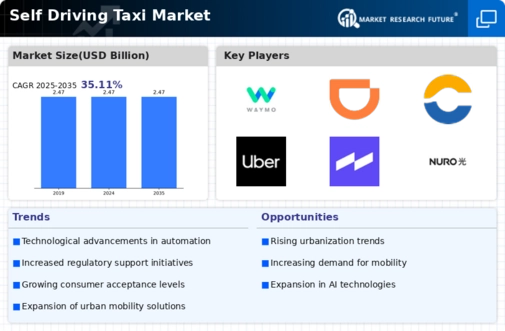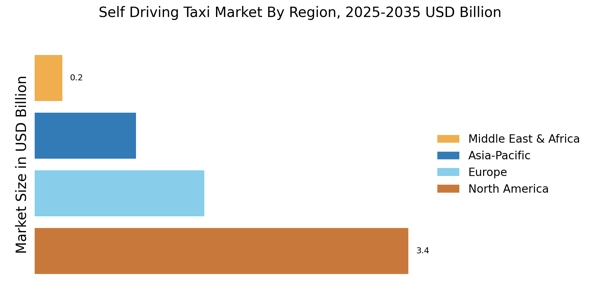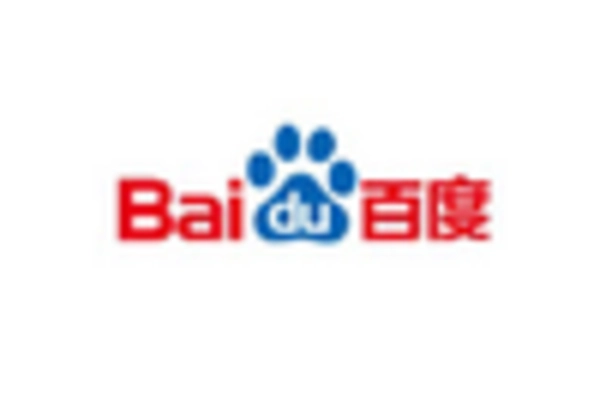North America : Innovation and Leadership Hub
North America is the largest market for self-driving taxis, holding approximately 55% of the global market share. The region's growth is driven by significant investments in technology, favorable regulatory frameworks, and increasing consumer acceptance. Key players like Waymo and Cruise are leading the charge, supported by government initiatives aimed at enhancing autonomous vehicle infrastructure. The second largest market is Europe, accounting for around 25% of the market share, driven by stringent regulations and a push for sustainable transport solutions.
The competitive landscape in North America is robust, with major players such as Waymo, Cruise, and Aurora at the forefront. These companies are leveraging advanced AI and machine learning technologies to enhance safety and efficiency. The presence of tech giants and automotive manufacturers in the region fosters innovation, while partnerships with local governments facilitate pilot programs and testing. This dynamic environment positions North America as a leader in the self-driving taxi market.
Europe : Regulatory Framework and Innovation
Europe is the second largest market for self-driving taxis, holding about 25% of the global market share. The region's growth is propelled by stringent regulations aimed at ensuring safety and environmental sustainability. Countries like Germany and the UK are at the forefront, implementing policies that encourage the development and deployment of autonomous vehicles. The European Union is actively working on harmonizing regulations across member states, which is expected to further boost market growth.
Leading countries in Europe include Germany, the UK, and France, where companies like Baidu and Didi Chuxing are making significant inroads. The competitive landscape is characterized by collaborations between automotive manufacturers and tech firms, fostering innovation in autonomous driving technologies. The presence of established automotive giants alongside startups creates a vibrant ecosystem, positioning Europe as a key player in the self-driving taxi market.
Asia-Pacific : Rapid Growth and Adoption
Asia-Pacific is witnessing rapid growth in the self-driving taxi market, accounting for approximately 15% of the global market share. The region's expansion is driven by increasing urbanization, rising demand for smart transportation solutions, and government support for autonomous vehicle initiatives. Countries like China are leading the charge, with significant investments in infrastructure and technology to facilitate the deployment of self-driving taxis. The competitive landscape is evolving, with local players like Pony.ai and Didi Chuxing gaining traction alongside international firms.
China is the largest market in the region, supported by a favorable regulatory environment and a growing consumer base eager for innovative mobility solutions. The presence of key players such as Baidu and Didi Chuxing enhances competition, while partnerships with local governments enable extensive testing and deployment of autonomous vehicles. This dynamic environment positions Asia-Pacific as a significant player in the global self-driving taxi market.
Middle East and Africa : Emerging Market with Potential
The Middle East and Africa region is an emerging market for self-driving taxis, holding about 5% of the global market share. The growth is driven by increasing urbanization, investment in smart city initiatives, and a rising demand for innovative transportation solutions. Countries like the UAE are at the forefront, implementing policies that support the development of autonomous vehicles. The region's potential is further enhanced by collaborations between governments and private sector players to create conducive environments for testing and deployment.
In the competitive landscape, local startups and international players are exploring opportunities in the self-driving taxi market. The presence of key players like Nuro and Zoox indicates a growing interest in the region. As infrastructure improves and regulatory frameworks evolve, the Middle East and Africa are poised for significant growth in the self-driving taxi sector, making it an attractive market for investment and innovation.


















Leave a Comment